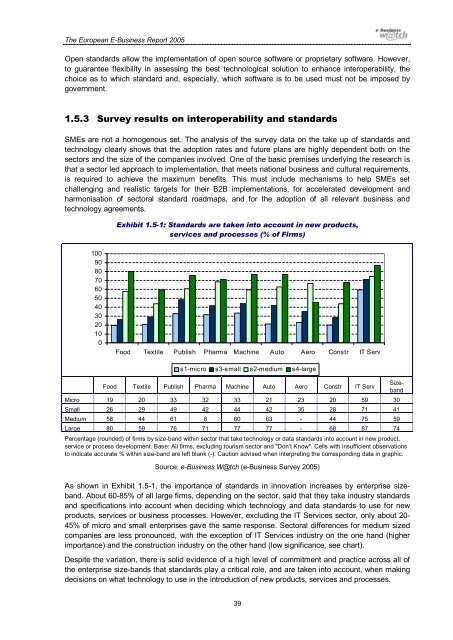The European e-Business Report The European e ... - empirica
The European e-Business Report The European e ... - empirica
The European e-Business Report The European e ... - empirica
You also want an ePaper? Increase the reach of your titles
YUMPU automatically turns print PDFs into web optimized ePapers that Google loves.
<strong>The</strong> <strong>European</strong> E-<strong>Business</strong> <strong>Report</strong> 2005<br />
Open standards allow the implementation of open source software or proprietary software. However,<br />
to guarantee flexibility in assessing the best technological solution to enhance interoperability, the<br />
choice as to which standard and, especially, which software is to be used must not be imposed by<br />
government.<br />
1.5.3 Survey results on interoperability and standards<br />
SMEs are not a homogenous set. <strong>The</strong> analysis of the survey data on the take up of standards and<br />
technology clearly shows that the adoption rates and future plans are highly dependent both on the<br />
sectors and the size of the companies involved. One of the basic premises underlying the research is<br />
that a sector led approach to implementation, that meets national business and cultural requirements,<br />
is required to achieve the maximum benefits. This must include mechanisms to help SMEs set<br />
challenging and realistic targets for their B2B implementations, for accelerated development and<br />
harmonisation of sectoral standard roadmaps, and for the adoption of all relevant business and<br />
technology agreements.<br />
Exhibit 1.5-1: Standards are taken into account in new products,<br />
services and processes (% of Firms)<br />
100<br />
90<br />
80<br />
70<br />
60<br />
50<br />
40<br />
30<br />
20<br />
10<br />
0<br />
Food Textile Publish Pharma Machine Auto Aero Constr IT Serv<br />
s1-micro s3-small s2-medium s4-large<br />
Food Textile Publish Pharma Machine Auto Aero Constr IT Serv<br />
Micro 19 20 33 32 33 21 23 20 59 30<br />
Small 26 29 49 42 44 42 35 28 71 41<br />
Medium 58 44 61 8 60 63 - 44 75 59<br />
Large 80 59 76 71 77 77 - 68 87 74<br />
Percentage (rounded) of firms by size-band within sector that take technology or data standards into account in new product,<br />
service or process development. Base: All firms, excluding tourism sector and "Don’t Know". Cells with insufficient observations<br />
to indicate accurate % within size-band are left blank (-). Caution advised when interpreting the corresponding data in graphic.<br />
Source: e-<strong>Business</strong> W@tch (e-<strong>Business</strong> Survey 2005)<br />
As shown in Exhibit 1.5-1, the importance of standards in innovation increases by enterprise sizeband.<br />
About 60-85% of all large firms, depending on the sector, said that they take industry standards<br />
and specifications into account when deciding which technology and data standards to use for new<br />
products, services or business processes. However, excluding the IT Services sector, only about 20-<br />
45% of micro and small enterprises gave the same response. Sectoral differences for medium sized<br />
companies are less pronounced, with the exception of IT Services industry on the one hand (higher<br />
importance) and the construction industry on the other hand (low significance, see chart).<br />
Despite the variation, there is solid evidence of a high level of commitment and practice across all of<br />
the enterprise size-bands that standards play a critical role, and are taken into account, when making<br />
decisions on what technology to use in the introduction of new products, services and processes.<br />
Sizeband<br />
39

















